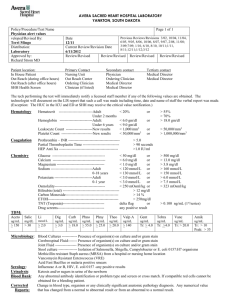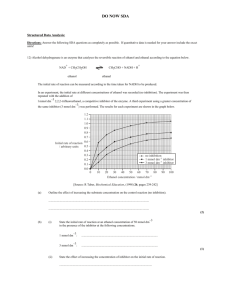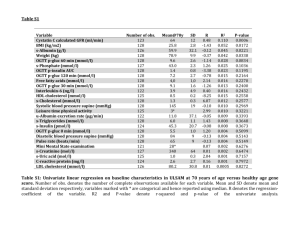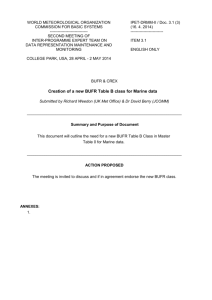Supplemental Information Synthesis and Solution Properties of a
advertisement
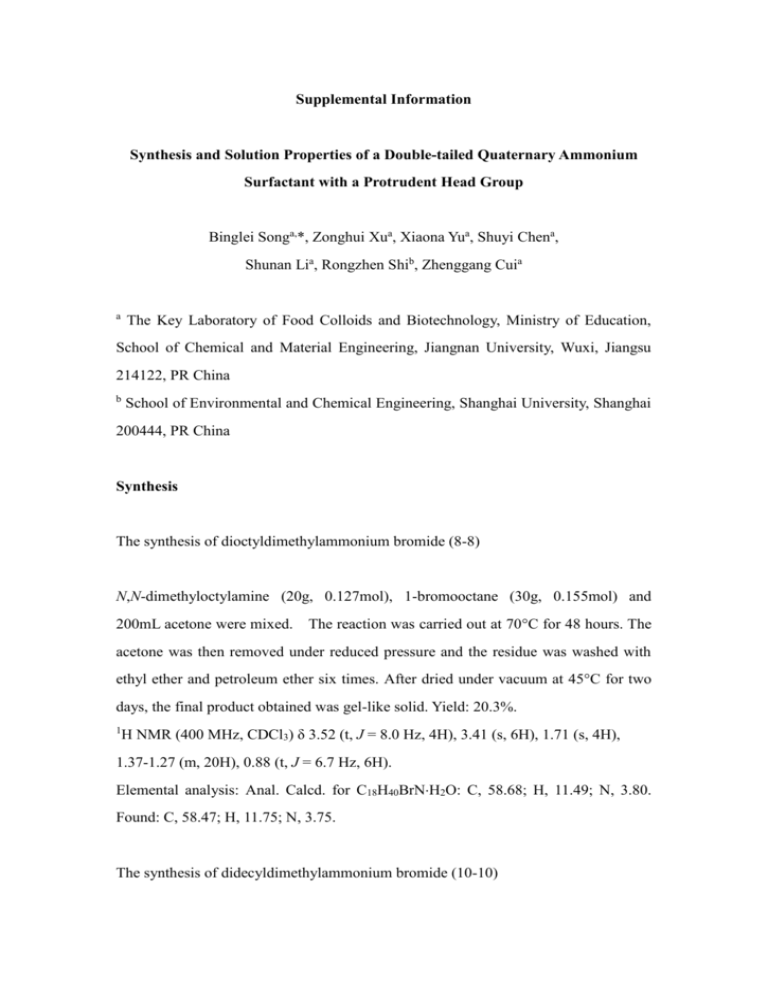
Supplemental Information Synthesis and Solution Properties of a Double-tailed Quaternary Ammonium Surfactant with a Protrudent Head Group Binglei Songa,*, Zonghui Xua, Xiaona Yua, Shuyi Chena, Shunan Lia, Rongzhen Shib, Zhenggang Cuia a The Key Laboratory of Food Colloids and Biotechnology, Ministry of Education, School of Chemical and Material Engineering, Jiangnan University, Wuxi, Jiangsu 214122, PR China b School of Environmental and Chemical Engineering, Shanghai University, Shanghai 200444, PR China Synthesis The synthesis of dioctyldimethylammonium bromide (8-8) N,N-dimethyloctylamine (20g, 0.127mol), 1-bromooctane (30g, 0.155mol) and 200mL acetone were mixed. The reaction was carried out at 70°C for 48 hours. The acetone was then removed under reduced pressure and the residue was washed with ethyl ether and petroleum ether six times. After dried under vacuum at 45°C for two days, the final product obtained was gel-like solid. Yield: 20.3%. 1 H NMR (400 MHz, CDCl3) δ 3.52 (t, J = 8.0 Hz, 4H), 3.41 (s, 6H), 1.71 (s, 4H), 1.37-1.27 (m, 20H), 0.88 (t, J = 6.7 Hz, 6H). Elemental analysis: Anal. Calcd. for C18H40BrNH2O: C, 58.68; H, 11.49; N, 3.80. Found: C, 58.47; H, 11.75; N, 3.75. The synthesis of didecyldimethylammonium bromide (10-10) N,N-dimethyldecylamine (10g, 0.06mol), 1-bromodecane (13g, 0.067mol) and 100mL acetone were mixed. The reaction was carried out at 70°C for 48 hours. The acetone was then removed under reduced pressure. The residue was recrystallized with petroleum ether three times. After dried under vacuum at 45°C for two days, the final product obtained was white solid. Yield: 29%. 1 H NMR (400 MHz, CDCl3) δ 3.51 (t, J = 8.0 Hz, 4H), 3.42 (s, 6H), 1.70 (s, 4H), 1.36-1.26 (m, 28H), 0.88 (t, J = 6.8 Hz, 6H). Elemental analysis: Anal. Calcd. for C22H48BrNH2O: C, 62.24; H, 11.87; N, 3.30. Found: C, 61.95; H, 11.92; N, 3.11. The synthesis of didodecyldimethylammonium bromide (12-12) N,N-dimethyldodecylamine (10g, 0.045mol), 1-bromodecane (12g, 0.05mol) and 100mL acetone were mixed. The reaction was carried out at 70°C for 48 hours. The acetone was then removed under reduced pressure. The residue was recrystallized with petroleum ether three times. After dried under vacuum at 45°C for two days, the final product obtained was white solid. Yield: 58%. 1 H NMR (400 MHz, CDCl3) δ 3.52 (t, J = 8.6 Hz, 4H), 3.42 (s, 6H), 1.70 (s, 4H), 1.36-1.26 (m, 36H), 0.88 (t, J = 6.8 Hz, 6H). Elemental analysis: Anal. Calcd. for C26H56BrN: C, 67.50; H, 12.20; N, 3.03. Found: C, 67.30; H, 12.02; N, 2.95. Dynamic light scattering 0.6 100 1 10.0 mmolL 0.0 0.8 0 100 1 5.0 mmolL 0 100 0.0 0.6 1 Intensity 3.0 mmolL G() 1 10.0 mmolL 1 5.0 mmolL 1 3.0 mmolL 0 100 0.0 0.3 1 1.5 mmolL 1 1.5 mmolL 0 100 0.0 0.3 1 1.0 mmolL 1 1.0 mmolL 0 0.0 10 -1 10 0 10 1 10 2 /s 10 3 10 4 10 5 10 0 10 1 10 2 10 3 Rh,app /nm Fig.S1 Time correlation functions for 2-ODTAB at different concentrations (left) and their corresponding intensity-fraction distributions measured at a detector angle 90o = 100 60mmolL-1 0 100 30mmolL Intensity(a.u.) -1 G( ) 60mmolL-1 20mmolL-1 30mmolL-1 0 100 20mmolL-1 0 100 10mmolL-1 10mmolL-1 0 -1 10 0 10 1 10 2 10 s 3 10 10 4 10 5 -1 10 0 10 1 10 10 2 10 3 Rh/nm Fig.S2 Time correlation functions for 8-8 at different concentrations (left) and their corresponding intensity-fraction distributions measured at a detector angle 90o = 10.0 mmolL 0 100 1 2.0 mmolL 1 1.5 mmolL 1 1.0 mmolL 0.5 mmolL 10.0 mmolL 0 100 2.0 mmolL 0 100 1 1.0 mmolL 0 100 1 1 1.5 mmolL 0 100 1 1 5.0 mmolL Intensity G( ) 5.0 mmolL 100 1 0.5 mmolL 1 1 1 0 10 -1 10 0 10 1 10 2 10 3 10 4 10 5 10 6 s 10 0 10 1 10 2 10 3 10 4 Rh,app/nm Fig.S3 Time correlation functions for 10-10 at different concentrations (left) and their corresponding intensity-fraction distributions measured at a detector angle 90o CONTIN Model (right) = 1 100 0.5 mmolL 1 0 100 0.2 mmolL 0.1 mmolL 1.0 mmolL 0 100 1 0.2 mmolL 0 100 1 1 0.5 mmolL Intensity G( ) 1.0 mmolL 0.1 mmolL 1 1 1 0 10 -1 10 0 10 1 10 2 10 3 10 4 10 5 10 6 s 10 0 10 1 10 2 10 3 10 4 Rh,app/nm Fig.S4 Time correlation functions for 12-12 at different concentrations (left) and their corresponding intensity-fraction distributions measured at a detector angle 90o CONTIN Model (right) =




